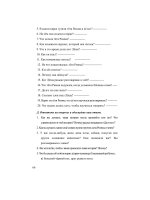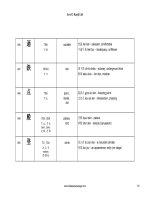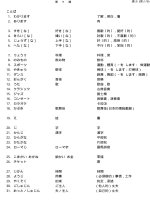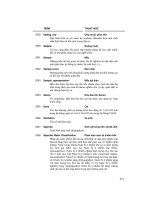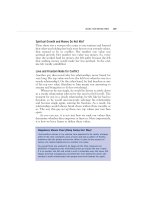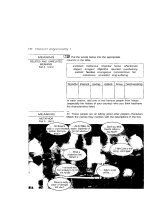betty azar grammar plus phần 9 doc
Bạn đang xem bản rút gọn của tài liệu. Xem và tải ngay bản đầy đủ của tài liệu tại đây (493.1 KB, 35 trang )
280
Worksheet 92: (CONTINUED)
© 1997 Prentice Hall Regents. Duplication for classroom use is permitted.
Fun with Grammar
Because Kim lost her car keys,
I went to class even though
Before I called my mother,
Since I had lived there for five years,
I was born in Mexico, yet
Every day there is more information about the dangers of smoking;
therefore,
My brother got involved with bad people; as a result,
I don’t like the taste of carrots, nor
While my mother likes to stay home and watch movies on TV,
While I was walking down the street,
As long as you are happy,
He seemed happy; however,
✄
281
Worksheet 93: JUST BECAUSE
© 1997 Prentice Hall Regents. Duplication for classroom use is permitted.
Fun with Grammar
With your partner, select two sentences from the list and combine them
using because. Be sure your sentences are logical and grammatical.
Remember to punctuate correctly.
She studied hard for her final
exams.
She took aspirin.
Air pollution in California is
increasing.
The bus was late.
My sister doesn’t work outside
the house.
I was late for work.
She has a migraine headache.
She wants to get into a good
university.
I ate breakfast at 7:00
A.M.
I’m not going to go camping.
She has six children.
I had to go to work.
Don’t eat too much for lunch.
My in-laws are coming for a visit.
It’s impossible to see out the front
window.
More and more people are driving
alone.
We are going to a great restaurant
for dinner.
You should wash your car.
It’s been raining all day.
I spent the day cleaning the house.
15.1 ADVERB
• Guess Who?
• Finish This
15.2 ADJECTIVE
• Definition Competition
• Picture Sentences
• Who Am I?
15.3 NOUN
•Song
• Completions
• Respond to the Question
• The Fact That
• Match Game
• Solve the Mystery
• Orders Subjunctive
• Question Draw
(Subjunctive form)
• Change It (Quoted/
Reported speech)
• Interview (Quoted/
Reported speech)
15.4 REVIEW
• Combinations
Clauses
15
283
15.1 ADVERB
1. GUESS WHO?
Materials: None
Dynamic: Whole class/Groups
Time: 20 minutes
Procedure: 1. Write 10 phrases on the board.
Examples: borrow money eat pizza
have my first kiss eat too much
go to a movie go to bed
go out to eat go dancing
go to the mall stay up late
2. Instruct the students to write a sentence using each of the phrases
and an adverbial subordinator. The sentences may use any logical
tense/time. You may want to list adverbial subordinators on the
board.
Examples: I borrowed money after I lost my wallet.
I had my first kiss when I was 14 years old.
3. Collect individual papers as they are completed. You can be noting
unusual sentences to read aloud and have the class guess who
wrote them.
Variation 1: As a follow-up activity, you can use the students’ sentences to create a
game to review adverbial subordinators at the end of the unit. Divide
the sentences into two columns with the main clause on the left and
the dependent clause (with the adverbial subordinator) on the right.
Cut them apart and mix them up. Divide the class into teams and
hand out the strips containing clauses to the teams. Have the students
make as many logical sentences as possible. (It is not necessary to
duplicate the original sentences as long as the ones they create as a
team are logical.) The team with the most logical sentences wins.
Variation 2: Give 20 cards or slips of paper to each group. Have them write 10
sentences, with the adverb clause on one paper and the independent
clause on another. Collect the 20 papers from each group and give
them to a different group. Tell the groups to match the independent
and dependent clauses written by the other group. The first group who
matches all the clauses to form logical sentences wins. (It is not
absolutely necessary to match every sentence as it was written, but it
may not be possible to come up with 10 logical sentences otherwise.)
2. FINISH THIS
Materials: None
Dynamic: Small groups
Time: 15 minutes
Procedure: 1. Divide the class into groups of three or four. Each group makes a
list of clauses containing an adverbial subordinator. (The number
of clauses you want your students to list will depend on how much
time you have for this activity.)
Examples: I get scared when
Before I got to class,
I always eat pizza after
2. To play a round, Group 1 reads one of its clauses for Group 2.
Group 2 must complete the sentence. If they do so correctly, they
get a point.
3. Group 2 then reads a sentence for Group 3 to complete. Continue
until all clauses have been completed.
15.2 ADJECTIVE
1. DEFINITION COMPETITION
Materials: Slips of paper, a noun written on each
A paper bag
Dynamic: Teams
Time: 15 minutes
Procedure: 1. Use a variety of nouns that denote things, people, places, time
periods (months or holidays), and so on. Put the slips of paper into
the bag and divide the class into two teams.
2. A student from the first team comes to the front and picks a paper
from the bag. The student then gives his/her teammates one clue
about the noun, using the phrase “I’m thinking of a thing
(person/place/animal/etc.) . . .” and an adjective clause to complete
the clue. It is helpful if you write this starting phrase on the board.
Sample clue: I am thinking of an animal that is orange with
black stripes.
284
285
3. After the first clue has been given, the first person on the clue-
giver’s team to raise his/her hand can guess the noun. If the
answer is correct, his/her team gets a point. If the answer is
incorrect, the clue-giver gives another clue, again using an
adjective clause. This time, anyone on either team may guess, and
the team of the person who answers correctly gets the point.
4. Repeat steps 2 and 3 with a student from the other team.
Continue alternating between teams. The team with the most
points at the end wins.
2. PICTURE SENTENCES
Materials: Large pictures
Dynamic: Pairs
Time: 10 minutes
Procedure: 1. Try to find full-page ads that can be seen when held up. Put
students into pairs, and give each pair a picture.
2. Have the pairs write a sentence containing an adjective clause
about their picture.
Example: The man who is next to the president is holding a
book.
3. The pairs hold up their pictures and read their sentences to the
class.
4. Last, the pairs write a reduction of their sentence, if possible.
Example: The man next to the president is holding a book.
3. WHO AM I?
Materials: Slips of paper, each containing the name
of a different student in the class
Dynamic: Whole class
Time: 25 minutes
Procedure: 1. Tell the students that you are going to take on the identity of one of
them. Choose a student and then describe yourself as if you were
that student. Use physical and personality details and the structure
“I am someone who . . .” or “I am the kind of person who . . .”
2. Distribute the slips of paper. Each student is to take on the
identity of the name on his/her paper and write five sentences to
describe himself/herself, using the structure indicated above.
3. Have the class get up and circulate. They must try to find
themselves in the crowd by listening to other students describe
themselves in the new identity. (You can circulate and listen for
examples and errors.)
4. The first person to find himself/herself is the winner, but have
everyone find himself/herself before you stop play if time permits.
NOTE: This activity works best with a class that has worked
together for awhile and who are familiar with one another.
15.3 NOUN
1. SONG
Materials: Worksheet 94
Tape player and music
Dynamic: Pairs
Time: 10 minutes
Procedure: 1. Tell students that you are going to play a song. They are to listen
for noun clauses and count them. Remind the students that there
can be clauses where “that” has been eliminated. Play the song
once.
2. Ask how many noun clauses were heard. Get several answers.
Play the song again, if desired, and recount.
3. Put students in pairs and give each pair a copy of the worksheet.
4. Have the pairs go through the song lyrics and underline all the
noun clauses.
5. Go through the words together and have the students identify
each noun clause as you come to it.
NOTE: The lyrics to “Amie” (Craig Fuller, sung by Pure Prairie
League) are provided in the worksheet as an example. If you do not
have the music, you could read it to your students, but it is best to
find a song with noun clauses for which you have the music.
Another good song to use is “Don’t Pass Me By” (Richard Starkey,
sung by the Beatles).
286
287
2. COMPLETIONS
Materials: Worksheet 95
Dynamic: Pairs
Time: 10 minutes
Procedure: 1. Put the students in pairs. Give each pair a copy of the worksheet
containing the six sentence fragments that they should complete
with a noun clause. Encourage them to use the names of students
from the class in their completions and to be silly if they want. You
may also suggest a topic for the sentences.
SUGGESTIONS: your classmates
elephants
outer space
another country
the opposite sex
unusual animals
2. Go around the class and have the pairs read their sentence
completions. You may also want to see if any of the students can
respond to a completed sentence. For example, if one pair writes “I
wonder why Marissa was absent today,” you may ask if anyone
knows why.
3. RESPOND TO THE QUESTION
Materials: Worksheets 96, cut into strips
Dynamic: Whole class/Teams
Time: 10 minutes
Procedure: 1. Give each student a strip with a question on it. If you use the
worksheet, fill in the blanks with the names of students from your
class. The students are to respond to the question, using a noun
clause.
Example:
On the strip: How many people live in Miami?
Possible responses:
I don’t know how many people live in Miami.
I don’t care how many people live in Miami.
Who knows how many people live in Miami? etc.
2. Have students take turns reading their question and their answer.
Variation: Divide the class into teams and have the students draw strips
alternately. If a student answers the question correctly (correct noun
clause form), the team gets a point. If you allow the team to work
together on the answer, accept the answer only from the student
who drew the strip.
4. THE FACT THAT
Materials: Worksheet 97
Dynamic: Pairs
Time: 15 minutes
Procedure: 1. To review noun clauses using the fact that, divide the class into
pairs. Give each pair a copy of the worksheet and have them work
together to combine the two sentences using “the fact that.”
2. Have each pair write one answer on the board. The other students
will critique the answers (Do the sentences combine the two
sentences grammatically? logically?).
5. MATCH GAME
Materials: Worksheet 98
Dynamic: Small groups
Time: 20 minutes
Procedure: 1. To review noun clauses, put students into groups of three to five.
Cut up the worksheet and randomly distribute cards to the groups.
Because the groups need to make matches, give an even number of
cards to each group even if one or two groups receive two more
cards than another group.
2. Each group tries to match its cards to make sentences that are
both grammatical and logical, observing the capitalization on the
cards (that is, they cannot change the capitalization).
3. Because cards were given out randomly, some of the cards will not
form matches. After making all the matches they can within their
groups, the students try to trade with other groups. They cannot
just take a card from another group, but must trade them. If one
group is unwilling to trade a certain card, the other group cannot
force them.
4. When one group has made all its matches and feels they are
correct, the game stops. One member of the group reads out the
matches to see if the class accepts the match. (You may need to
referee if the class rejects a logical, grammatical answer.
Sometimes this happens if the class does not want the group to
win [and thus the game to end].)
288
289
5. If all matches are accepted, the group wins. If any of the matches
is rejected, the game continues until another (or the same) group
feels it has matched all cards. There can be no unmatched cards.
6. SOLVE THE MYSTERY
Materials: Worksheets 99A and 99B or a 3”x 5” card
for each student and a list of information
the students must obtain
A piece of paper for each student
Dynamic: Whole class
Time: 30 minutes
Procedure: 1. Copy and cut Worksheet 99A, making sure there will be one card
for each of your students. The first seven cards must be used. Use
as many of the others as you have students in the class. (You may
have to duplicate the worksheet or make others yourself if you
have a large class.) If you choose not to use the worksheet, make
cards with similar information on them.
2. Have the students number their papers 1–7, and ask them to
write the following information:
1. the name of a student in the class
2. the name of a thing that can be carried
3. the name of another student in the class
4. a money amount
5. complete the sentence: He/She did it because
6. the name of another student in the class
7. a location in your house
3. Collect the papers and draw seven at random. Use a different
student paper to fill in the information on the first seven cards on
the worksheet. (Take the name of a student in the class from the
first paper, the name of a thing that can be carried from the second
paper, the name of another student in the class from the third
paper, and so on.)
4. Distribute the cards randomly so that seven students have a clue
card (with the blank now filled in) and the rest of the students
have the other cards from the worksheet. Tell the students that a
crime has been committed and they must solve the crime by
finding the answer to the questions on Worksheet 99B. Either give
each student a copy of the questions, or write the questions on the
board or on an overhead transparency.
5. The students circulate and ask each other the questions, making
sure to preface each question with an expression such as “Can you
please tell me . . .?” or “Do you know . . .?” with the rest of the
question converted into a noun clause.
Example: “Whose was it?” becomes “Do you know whose it was?”
If the question is not phrased properly, the student being asked
may refuse to answer the question. Students who have the
requested information must respond to a correctly worded
question truthfully. Students who do not have the answer must
use the phrase on their cards, followed by a noun clause.
Example: I don’t know how much it costs.
I don’t have the foggiest idea who stole it.
6. The first student to acquire all of the requested information wins.
7. ORDERS SUBJUNCTIVE
Materials: Worksheet 100
Dynamic: Teams
Time: 10 minutes
Procedure: 1. Cut up the worksheet. Divide the class into two teams and have
them line up on either side of the room.
2. The first student from Team 1 comes to the front desk and draws a
slip of paper with an order on it. The student then puts that order
into a subjunctive sentence. Tell students not to repeat the same
verb used by their classmates, but to use a variety: demand, tell,
order, ask, etc.
Example:
Paper: Teacher to student: “Shut the door.”
Student response: She demanded that the student shut the
door.
3. If the student answers correctly, he/she scores a point for his/her
team. Then the other team takes a turn.
4. Repeat until all orders have been put into the subjunctive. The
team with the most points wins.
290
291
8. QUESTION DRAW (Subjunctive form)
Materials: Worksheet 101
Dynamic: Teams
Time: 10 minutes
Procedure: 1. Cut up the worksheet. Divide the class into two teams and have
them line up on either side of the room.
2. The first student from Team 1 comes to the front desk, draws a
slip of paper with a question on it, and reads it to the first student
on Team 2. That student answers the question, using the
subjunctive in a noun clause.
Example:
Question: What is it necessary that a person wear to class?
Answer: It is necessary that a person wear shoes to class.
3. If the student answers correctly, he/she scores a point for his/her
team. Then a student from the other team takes a turn.
4. Repeat until all questions have been chosen. The team with the
most points wins.
NOTE: Having one team read the question to the other team ensures
that everyone can hear the question.
9. CHANGE IT (Quoted/Reported speech)
Materials: Worksheet 102
Dynamic: Teams
Time: 10 minutes
Procedure: 1. Cut up the worksheet. Divide the class into two teams and have
them line up on opposite sides of the room.
2. A student from Team 1 comes to the front of the class and draws a
slip of paper with a sentence or question in quoted speech. The
student reads it to the first student in Team 2, who puts the
statement into reported speech.
Example: Student A: “Where can I meet you?”
Student B: She asked where she could meet me.
Student A: “Come here!”
Student B: He ordered me to go there.
3. After all members of Team 2 have responded, reverse roles so that
the students in Team 2 ask the questions.
10. INTERVIEW (Quoted/Reported speech)
Materials: Worksheet 103
Dynamic: Pairs
Time: 30 minutes
Procedure: 1. Review quoted speech, making sure students understand how
quoted speech is represented in English for statements, questions,
and commands. Divide the students into pairs.
2. The partners use the worksheet to collect samples of quoted
speech from each other. Then they rewrite their partner’s quoted
speech as reported speech.
NOTE: You can wait until you have covered all the relevant reported
speech structures in the book before you assign this task, or you can
have the students do each section as they learn it.
15.4 REVIEW
1. COMBINATIONS
Materials: Worksheet 104
Dynamic: Pairs
Time: 15 minutes
Procedure: 1. Have students work in pairs. Give each pair one copy of the
worksheet.
2. The students are to combine the sentences as directed on the
worksheet.
3. When all pairs have finished, go over the worksheet together by
asking for volunteers to read or write their sentences on the board.
NOTE: For a high-level class, eliminate the instructions regarding
what type of clause to use.
292
293
Worksheet 94: SONG
© 1997 Prentice Hall Regents. Duplication for classroom use is permitted.
Fun with Grammar
“Amie”
I can see why you think you belong to me;
I never tried to make you think or let you see
One thing for yourself.
But now you’re off with someone else and I’m alone.
You see, I thought that I might keep you for my own.
REPEAT
Amie, what ’choo wanna do?
I think I could stay with you
For awhile, maybe longer, if I do.
Don’t you think the time was right for us to find
All them things we thought weren’t proper
Could be right in time.
And, can you see
Which way we should turn together or alone.
I can’t never tell what’s right or what is wrong.
(It’d take too long to see)
REPEAT
Well, now it’s come to what you want; you’ve had your way.
And all the things you thought before just faded into gray.
And can you see
A-That I don’t know if it’s you or if it’s me.
If it’s one of us, I’m sure we both will see
(Oh, won’t you look at me and tell me)
REPEAT
I just keep falling in and out of love with you,
Falling in and out of love with you,
Don’t know what I’m gonna do,
I keep falling in and out of love with you.
“Amie,” words and music by Craig Lee Fuller
©1971, 1975 McKenzie Music & Unichappell Music, Inc. (BMI)
All Rights Administered by Unichappell Music, Inc. (BMI)
All Rights Reserved Used by Permission
WARNER BROS. PUBLICATIONS U.S., INC., Miami, FL 33014
294
Worksheet 95: COMPLETIONS
© 1997 Prentice Hall Regents. Duplication for classroom use is permitted.
Fun with Grammar
I’d like to know . . .
I wonder . . .
Can you tell me . . .
Please tell me . . .
Do you know . . .
I don’t know . . .
I’d like to know . . .
I wonder . . .
Can you tell me . . .
Please tell me . . .
Do you know . . .
I don’t know . . .
I’d like to know . . .
I wonder . . .
Can you tell me . . .
Please tell me . . .
Do you know . . .
I don’t know . . .
295
Worksheet 96: RESPOND TO THE QUESTION
© 1997 Prentice Hall Regents. Duplication for classroom use is permitted.
Fun with Grammar
How many people live in Miami?
How often does
study?
Why was absent
yesterday?
Where is the head of our program
today?
Where is Omaha?
What is the capital of Japan?
What is ’s favorite
color?
How old is your grandmother?
What is ’s
telephone number?
What did eat for
dinner yesterday?
Why is always
smiling?
What is ’s middle
name?
How many brothers and sisters
does have?
How did meet her
husband?
✄
296
Worksheet 96: (CONTINUED)
© 1997 Prentice Hall Regents. Duplication for classroom use is permitted.
Fun with Grammar
What is ’s favorite
animal?
Why do classes start at 8:00?
How tall is the Empire State
Building?
Who was that guy with
last night?
Who is the best cook in the class?
Who was the oldest U.S.
president?
What is the best place to go on
vacation?
When is the next test?
How many girlfriends does
have?
How many hours does it take to
drive from San Diego to San
Francisco?
How many legs does a centipede
have?
What is the average rainfall in
Panama?
How old is the teacher?
How much does
weigh?
✄
297
Worksheet 97: The Fact That
© 1997 Prentice Hall Regents. Duplication for classroom use is permitted.
Fun with Grammar
Combine the two sentences in each set, using the fact that. Be sure your
resulting sentence is grammatical and logical.
1. A big dog lives on my street.
That scares me.
2. The bus didn’t come.
Because of that, I was late.
3. Yoichi didn’t study but got 100 percent.
I wonder about that.
4. My mother forgot my birthday.
That made me sad.
5. It’s cold today.
In spite of that, I’m going to the beach.
6. Ahmed was wearing a tie today.
I was stunned by that.
7. Hitoshi seemed sincere.
I wasn’t convinced by that.
8. The pyramids were built without the aid of machines.
That really amazes me.
9. My daughter graduated at the head of her class at Harvard.
That takes my breath away.
10. My dog chewed up my new book.
In spite of that, I still love her.
298
Worksheet 98: MATCH GAME
© 1997 Prentice Hall Regents. Duplication for classroom use is permitted.
Fun with Grammar
Where Bob eats
lunch
I don’t know I wonder
It’s a miracle We don’t care We need to find out
How many husbands
she had
How much money I
earn
The fact that no one
has seen Brian
Everyone wants to
know
It bothers me What he has on
It’s a fact No one knows Let’s ask him
That she was in an
accident
I can’t imagine Could you tell me
is too bad was a secret is strange
✄
299
Worksheet 98: (CONTINUED)
© 1997 Prentice Hall Regents. Duplication for classroom use is permitted.
Fun with Grammar
what he is really
like
is a mystery where he lives
how old she is
that you forgot my
birthday
if she has a sister
is scary
if he knows how to
get to the ocean
that she agreed to go
on a date with you
whether or not she’s
busy tonight
where the party
will be
is none of your
business
what you were like
as a child
that he stole the
money
how often he goes
jogging
✄
300
Worksheet 99A: SOLVE THE MYSTERY
© 1997 Prentice Hall Regents. Duplication for classroom use is permitted.
Fun with Grammar
stole it.
He/She stole a
.
It was .
It cost .
He/She stole it
because .
He/She stole it from
.
Now it’s
.
I don’t have any
idea . . .
I don’t know . . .
I haven’t the foggiest
idea . . .
No one told me . . . I can’t imagine . . .
I’d like to know . . .
too.
I wish I knew . . .
It’s none of my
business . . .
No one knows . . . I can’t remember . . .
It’s a mystery to
me . . .
✄
301
Worksheet 99B: SOLVE THE MYSTERY
© 1997 Prentice Hall Regents. Duplication for classroom use is permitted.
Fun with Grammar
Who stole something? Who stole something?
What did he/she steal? What did he/she steal?
Whose was it? Whose was it?
How much did it cost? How much did it cost?
Why did he/she steal it? Why did he/she steal it?
Who did he/she steal it from? Who did he/she steal it from?
Where is it now? Where is it now?
Who stole something? Who stole something?
What did he/she steal? What did he/she steal?
Whose was it? Whose was it?
How much did it cost? How much did it cost?
Why did he/she steal it? Why did he/she steal it?
Who did he/she steal it from? Who did he/she steal it from?
Where is it now? Where is it now?
Who stole something? Who stole something?
What did he/she steal? What did he/she steal?
Whose was it? Whose was it?
How much did it cost? How much did it cost?
Why did he/she steal it? Why did he/she steal it?
Who did he/she steal it from? Who did he/she steal it from?
Where is it now? Where is it now?
✄
✄
✄
302
Worksheet 100: ORDERS SUBJUNCTIVE
© 1997 Prentice Hall Regents. Duplication for classroom use is permitted.
Fun with Grammar
Mother to child: “Be
careful!”
Teacher to student:
“Stay after class.”
Teacher to student:
“Study for the test.”
Mother to son: “Be
home by 5:00.”
Friend to friend:
“Drive more
carefully.”
Father to child: “Eat
your vegetables.”
Mother to daughter:
“Get your hair cut.”
Friend to friend: “Be
here in an hour.”
Father to son: “Don’t
spend all your
money.”
Museum official to
visitor: “Don’t touch
that!”
Sister to sister: “Don’t
tell anyone my
secret.”
Test official to
worker: “Don’t admit
anyone after 1
P.M.”
Teacher to student:
“Take the
Institutional TOEFL.”
Mother to child:
“Clean up your mess.”
Friend to friend: “Buy
a new car.”
Friend to friend: “Tell
me the truth.”
Father to child: “Don’t
lie to me!”
Advisor to student:
“Apply to colleges
early.”
✄
303
Worksheet 101: QUESTION DRAW
© 1997 Prentice Hall Regents. Duplication for classroom use is permitted.
Fun with Grammar
What have your
parents insisted that
you do?
What do you suggest
your brother do?
What is it important
that students do?
What is it vital that a
doctor do?
What do you propose
that we do after
class?
What does the
teacher recommend
that you do?
What have you asked
that your parents do?
What is it necessary
that a pilot have?
What do you advise
that your friend do?
What has a doctor
suggested that you
take?
What has someone
requested that you
do?
What is it necessary
that a teacher do?
What is it vital that
the government do to
decrease crime?
What do you request
that your friends call
you?
What is it essential
that a person do
before going to a
foreign country?
What is it imperative
that a driver do when
he/she hears a fire
engine coming?
What have you asked
that your boyfriend/
girlfriend/spouse do?
What meal is it most
important that a
person eat?
✄
304
Worksheet 102: CHANGE IT
© 1997 Prentice Hall Regents. Duplication for classroom use is permitted.
Fun with Grammar
“Read chapter 6 for
homework.”
“Pick up your
clothes!”
“You should drive
more carefully.”
“It will rain
tomorrow.”
“I’m watching the
news.”
“I was angry
yesterday.”
“I’ve already read
this book.”
“Do you have an
extra pencil?”
“I have already seen
that movie.”
“I have a headache.” “Put that back!”
“I have to work
tonight.”
“Are you still
studying?”
“I am going to take a
bath now.”
“Can I have those
French fries?”
“Is that your sister?”
“I ate dinner at
10:00.”
“I must go now.”
“Do you have any
money?”
“I might go out
tonight.”
“I may be late.”
✄

